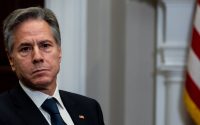Trump, Weighing In on Auto Strike, Has a Mixed Legacy on Unions
As a businessman, Donald J. Trump at first tried to circumvent labor unions, then spent decades largely appeasing them to avoid costly strikes.
During his first presidential campaign, he boiled down labor issues to a grievance about other countries taking advantage of the United States.
As president, he made appointments and adopted policies often more antagonistic to organized labor than those of many other Republicans.
When Mr. Trump arrives in the Detroit area on Wednesday to interject himself into the United Auto Workers strike, he will bring with him a record of interactions with organized labor that, whether out of pragmatism or opportunism, has few straight lines.
What may resonate the loudest with the current and former factory workers whom Mr. Trump hopes to reach is his decades-long history of reducing a host of economic and labor issues to the complaint that America’s leaders have allowed other countries to “rip off” the United States. He used that line of reasoning in announcing the Michigan trip, arguing that “dumb” government programs to promote electric vehicles would push all automobile production to China. “The all Electric Car is a disaster for both the United Auto Workers and the American Consumer,” he wrote on his Truth Social platform.
He deployed the same logic in criticizing Shawn Fain, the United Auto Workers’ president, though what he thought Mr. Fain should do differently was not clear. “I think he’s not doing a good job in representing his union, because he’s not going to have a union in three years from now,” Mr. Trump said in a recent interview broadcast on NBC’s “Meet the Press.” “Those jobs are all going to be gone because all of those electric cars are going to be made in China.”
In many ways, that argument is a replay of one of the greatest hits from Mr. Trump’s 2016 campaign, when he aligned himself with workers at a Carrier furnace plant in Indianapolis who faced layoffs after the company announced plans to move the operation to Mexico. At rally after rally, he said it would be easy for him to stop such departures, a message that appealed to former factory workers and those who felt at risk. In Detroit, that approach would allow him to strike a note of support to both workers and companies without choosing sides in the most consequential labor dispute in years.
Mr. Trump’s visit will serve other political purposes as well. He has scheduled a prime-time speech at an auto parts manufacturer as a distraction from the Republican primary debate he chose not to attend, much as his interview with Tucker Carlson was scheduled to be released during the last primary debate. And in the contest to win over blue-collar voters, the appearance pits him directly against President Biden, who on Tuesday took the unusual step of appearing with Mr. Fain and speaking out in support of the union’s contract demands.
Mr. Trump’s early interactions with labor unions were based on less complex concerns. As a young real-estate developer in 1980, Mr. Trump hired a nonunion crew of 200 undocumented Polish workers to demolish the Bonwit Teller department store on Fifth Avenue in Manhattan, clearing the way for what would become Trump Tower, his signature building and the first new construction he pursued on his own. The men were paid as little as $4 an hour, less than half the union wage, and worked 12-hour shifts without safety gear. Though he saved money in the short term, the long-term costs were significant. The treatment of those workers led to 15 years of litigation. Mr. Trump paid $1.375 million to settle the case, including a $500,000 payment to a union benefits fund. The terms of the settlement remained sealed until Mr. Trump became president and a judge released them over his objections.
For the rest of his building career, Mr. Trump generally hired large construction companies, allowing him to complete major projects with a minimum number of full-time employees. Those companies typically handled the hiring and management of union workers. It was an era when organized crime lorded over many of the building trade unions in New York.
“We had very little, if anything, to do with the unions,” said Barbara Res, who oversaw the construction of Trump Tower for Mr. Trump and worked with him for years. “That’s one of the benefits of having a construction manager. They take care of that crap.”
When Mr. Trump ran casinos in Atlantic City, the owners negotiated as an association with the local hotel and casino workers union. John R. O’Donnell, who managed the Trump Plaza casino for several years starting in the late 1980s, said Mr. Trump was so terrified by the threat of lost business during a strike that he would mine his fellow association members and their lawyers for details on the owners’ strategy and then surreptitiously pass that information along to local union leaders. He said Mr. Trump’s typical efforts to reduce costs “did not apply when it came to the union,” because he was adamant that a strike “cannot happen.”
“He worked against the association to help the unions, to the detriment of the rest of the city,” Mr. O’Donnell said. “He was going to sign a contract regardless.”
In New York City, Mr. Trump developed a professional relationship with Peter Ward, the longtime president of the Hotel and Gaming Trades Council, which had members working in Trump-owned or -operated hotels. In 2011, Mr. Ward led his union to support Mr. Trump’s brief effort to take over operation of the Tavern on the Green restaurant in Central Park, which had been closed by a bankruptcy.
“We have a long and good history with him,” Mr. Ward told The New York Post at the time of the Tavern on the Green agreement.
During the transition after Mr. Trump won the 2016 election, Mr. Ward was among those on the president-elect’s official schedule for a face-to-face meeting at Trump Tower.
Not all employees at Mr. Trump’s hotels and golf courses are unionized. Workers at the hotel that Mr. Trump co-owns in Las Vegas with the casino mogul Phillip Ruffin began a unionization drive in 2014. The owners pushed back against the effort, but ultimately signed a contract with the union the month after the 2016 election. In 2018, workers at the Trump National Golf Club in Bedminster, N.J., told a reporter for The New York Times that many employees there were undocumented immigrants; one worker said a manager had directed her to someone to help her obtain fraudulent records.
After decades taking a counterintuitive approach to organized labor as a business owner, Mr. Trump made a sharp turn to the right once elected. Two of his choices for top Labor Department posts had been reliable antagonists of organized labor throughout their careers: Andrew Puzder, who as chief executive of a fast-food company repeatedly argued that labor regulations stifled economic growth; and Patrick Pizzella, a conservative lobbyist and government official who had spent years promoting the interests of businesses against those of unions.
Mr. Puzder withdrew his nomination because of a lack of congressional support. Mr. Pizzella served as deputy secretary and acting secretary under Mr. Trump. As a lobbyist in the 1990s, he had been hired by the Northern Mariana Islands, a commonwealth of the United States where some workers earned less than $1 an hour, to ensure that Congress did not impose federal minimum wage and immigration laws there.
As president, Mr. Trump signed executive orders that undid longstanding protections for two million unionized federal workers, including making it easier to fire and discipline government employees. His appointees demoted the senior civil servants who resolved most labor cases. Mr. Trump has said that if re-elected he will fire thousands of federal workers whom he considers part of a “deep state” filled with “villains.”
His line of complaint about other countries taking advantage of the United States dates back to his earliest comments on national affairs. In September 1987, during the presidency of Ronald Reagan, Mr. Trump bought full-page advertisements in three major newspapers, including The Times, arguing that Japan, Saudi Arabia and other countries were “laughing at America’s politicians” because the United States paid their defense costs. “I was tired, and I think a lot of people are tired, of watching other countries ripping off the United States,” he said on CNN that night. “This is a great country. They laugh at us behind our backs. They laugh at us because of our own stupidity, and the leaders.”
Nearly 30 years later, during the 2016 presidential campaign, Mr. Trump repeated almost those exact words after a video of Carrier managers announcing layoffs to employees in the Indiana plant gained wide attention. He said such moves would stop under his presidency because he would impose a 35 percent tariff on goods shipped from foreign factories that had replaced plants in the United States. “We’re going to make our products here,” he said. “Companies are taking advantage of us. And countries are abusing us. And the way you stop it is so easy.”
The message resonated with voters at his rallies, as well as with Carrier employees. “I loved it,” Jennifer Shanklin-Hawkins, a worker at the company, told The Times. “I was so happy Trump noticed us.”
Mr. Trump never instituted the sort of targeted tax threat he said would be so easy. He and Mike Pence, the vice president and former governor of Indiana, did help persuade Carrier to keep about 850 of those 1,400 jobs in Indiana, in exchange for $7 million in incentives from the state. The rest of the workers were laid off, and hundreds more workers at a nearby Carrier factory were also let go. Some said they ended up feeling like props for the Trump campaign.
“There was still a layoff,” Ms. Shanklin-Hawkins told a reporter with The Indianapolis Star in 2020. “He lied completely.”
Noam Scheiber and Maggie Haberman contributed reporting.


